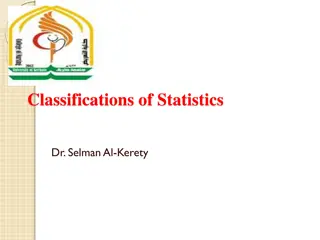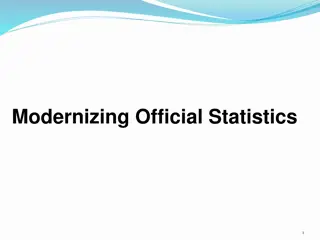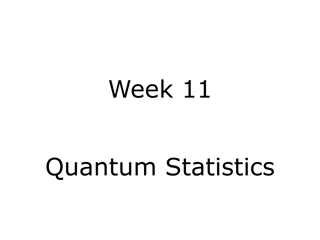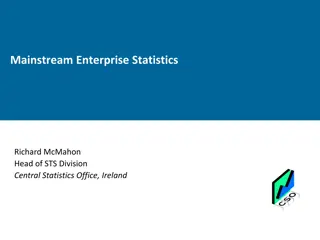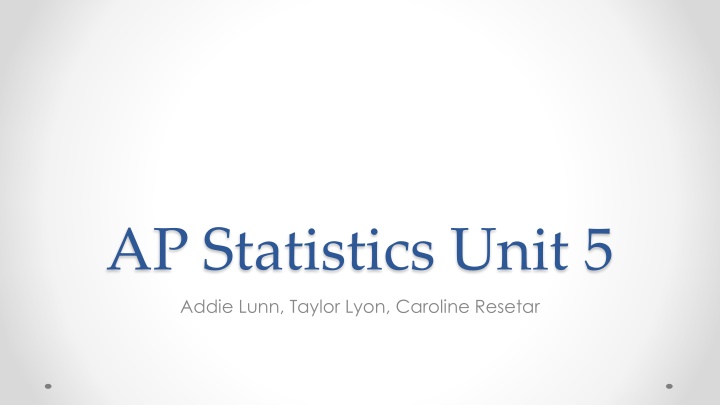
Statistics Concepts: Sampling, CLT, Formulas, Practice Problems
Explore key statistics concepts like sampling distributions, Central Limit Theorem (CLT), formulas for normality, and practice problems. Understand confidence intervals, proportions, and standard error in this comprehensive guide.
Download Presentation

Please find below an Image/Link to download the presentation.
The content on the website is provided AS IS for your information and personal use only. It may not be sold, licensed, or shared on other websites without obtaining consent from the author. If you encounter any issues during the download, it is possible that the publisher has removed the file from their server.
You are allowed to download the files provided on this website for personal or commercial use, subject to the condition that they are used lawfully. All files are the property of their respective owners.
The content on the website is provided AS IS for your information and personal use only. It may not be sold, licensed, or shared on other websites without obtaining consent from the author.
E N D
Presentation Transcript
AP Statistics Unit 5 Addie Lunn, Taylor Lyon, Caroline Resetar
Chapter 18 Sampling Distribution Models
Sampling Distributions A sampling distribution model for how a sample proportion varies from sample to sample allows us to quantify that variation and how likely it is that we d observe a sample proportion in any particular material. Using a normal model o for mean o for standard deviation
The Central Limit Theorem (CLT) The mean of a random sample is a random variable whose sampling distribution can be approximated by a Normal model. The larger the sample, the better the approximation will be.
Conditions for Normality In order to perform this test the following must be true: o Normal Model Unimodal Symmetric Bell shaped o Conditions Random <10% np 10 nq 10 Independent Large enough
Formulas When only given sample size: o ( ?)=P o = ??/? When given sample size and standard deviation: o ( ?)=P o ( ?)= ?
Practice Problem Groovy M&M s are supposed to make up 30% of the candies sold. In a large bag of 250 M&M s what is the probability that we get at least 25% groovy candies? .3 .7 250 = .029 o Normal cdf(.25, ,.3, .029) =.96 ?=
Chapter 19 Confidence Intervals and Proportions
Standard Error Whenever we estimate the standard deviation of a sampling distribution, we call it a standard error. o Formulas Sample Proportion oSE()= Sample Mean oSE()=
Confidence Intervals By the 68-95-99.7% rule we know that o About 68% of all samples will have ? s within 1 SE of p o About 95% of all samples will have ? s within 2 SE of p o About 99.7% of all samples will have ? s within 3 SE of p Each Confidence Interval uses a sample statistic to estimate a population parameter. Example: o There is a 95% chance that p is no more than 2 SE away from ?
Margin of Error We claim, with 95% confidence, that the interval ? 2??( ?) o The extent of the interval on either side of p is called the margin of error. We find the critical value by using inverse norm in the calculator ?? ? ME = z* Your critical value is represented by the z-score in the equation
Conditions Random Independent < 10% np 10 nq 10
Practice Problem A person interviews 50 of the 750 seniors in her high school and finds that 36 plan to go to the prom. Construct and interpret a 90% confidence interval. o = 36/50 =.72 N(.72,.063) .72 .28 50 o ? = =0.063 Prop z 1 interval (36,50, .90) = 0.62- 0.82 o I m 95% confident that the proportion mean of .72 is between .62 and .82.
Chapter 20 Testing Hypothesis About Proportions
Hypothesis Our staring hypothesis is the null hypothesis The null hypothesis that we denote is Ho The Alternative Hypothesis is Ha We retain that hypothesis until the facts make it unlikely beyond a reasonable doubt. We reject the null if there is no evidence to support the null. The null hypothesis specifies a population model parameter of interest and proposes a value for that parameter. Nothing can be proven.
P-Values We retain the null if the p-value is greater than 0.05 P-value 0.05 We reject the null if the p-value is less then 0.05 P-Value 0.05 The P-value is a conditional probability, meaning it is the probability that the observed results could have happened/occurred.
Alternative Alternatives Ha: Parameter < hypothesized value (one-sided) Ha: Parameter > hypothesized value (one-sided) - a one-sided alternative focuses on deviations from the null hypothesis value in only one direction Ha: Parameter hypothesized value (two-sided alternative) - for two-sided alternatives, the p-value is the probability of deviation in either direction from the null hypothesis value
Conditions Random Independent <10% np 10 nq 10
PRACTICE PROBLEM According to the Law School Admission Council, in the fall of 2006, 63% OF LAW School applicants were accepted into law school. The Training program LSAT claims that 168 of the 240 students trained in 2006 were admitted to law school. o Has LSAT demonstrated real improvement over the national Average? Ho= .63 Ha> .63 SE = pq/n = .63 .37/240 = .031 p-value = 0.012 N(.63,.031) Normal CDF(.7, 1, .63,.031) We reject the null, since the p-value is significantly less. Therefore there is no evidence to support that the LSAT demonstrated any improvement.
Chapter 21 More About Tests and Intervals
Zero in on the null To perform a hypothesis test, the null must be a statement about the value of a parameter for a model. We then use that value to figure out the probability that the observed sample statistic might occur.
P-values A large p-value doesn t prove that the null hypothesis is true, but it offers no evidence that it is not true. So when we see a large p-value, all we can say is that we don t reject the null hypothesis. (we retain the null hypothesis) When we see a small p-value, we could continue to believe the null hypothesis and conclude that we just witnessed a rare event. But instead, we trust the data and use it as evidence to reject the null hypothesis.
Alpha Levels and Confidence Intervals The Alpha level is denoted as Common alpha levels are 0.10, 0.05, 0.01. Because confidence intervals are two-sided, they correspond to two- sided tests -in general, a confidence interval with a confidence level of C% corresponds to a two-sided hypothesis test with an level of 100 C% One-sided test: alpha level of 100-C%/2
Chapter 22 Comparing two Proportions
Comparing Two Proportions Comparisons between two percentages are much more common than questions about isolated percentages. We want to know how the two groups differ, such as a treatment is better than a placebo
Two proportion z-Interval When the conditions are met, we are ready to find the confidence interval for the difference of two proportions Confidence Interval o (P1-P2) z* X SE (P1-P2) The Critical Value z* depends on the particular confidence level, C, that you specify.
formulas Standard Deviation of the difference between to sample proportions SD= Standard Error o SE=
Conditions Random <10% Independent np 10 nq 10













